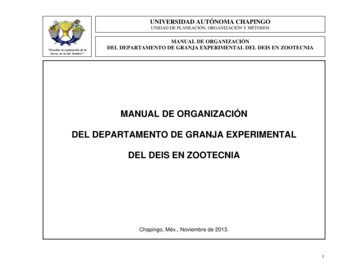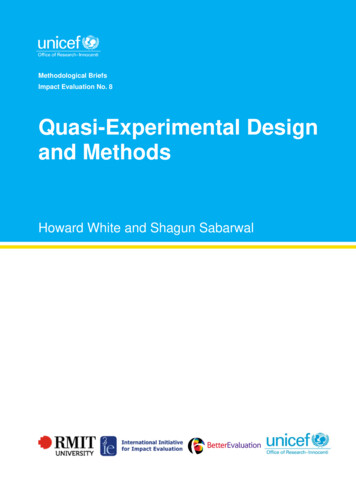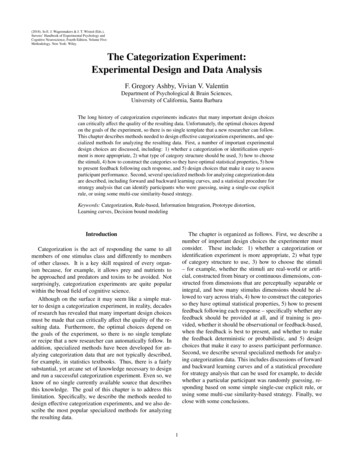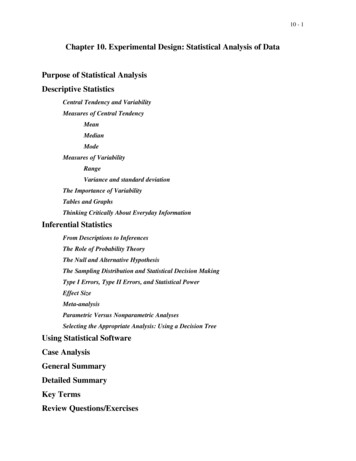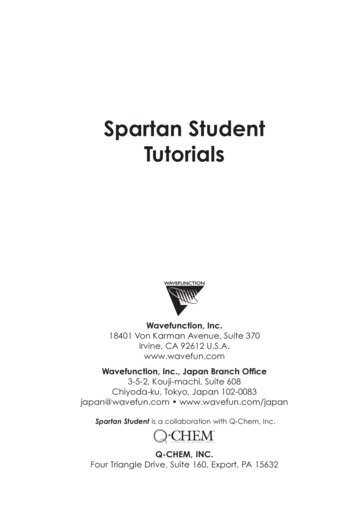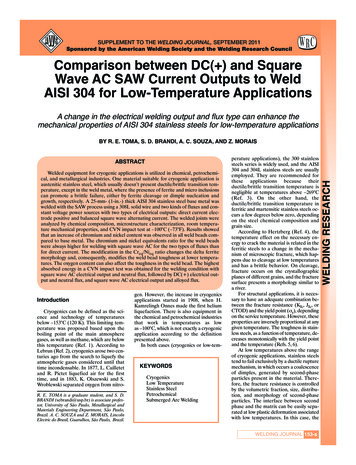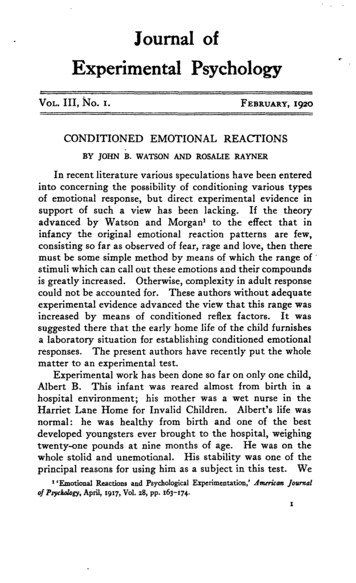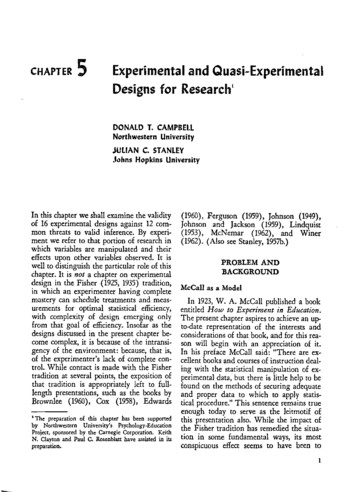
Transcription
Einreichung für: BTW 2017,Geplant als Veröffentlichung innerhalb der Lecture Notes in Informatics (LNI)An Experimental Analysis of Different Key-Value Storesand Relational DatabasesDavid Gembalczyk1 Felix Martin Schuhknecht2 Jens Dittrich3Abstract: Nowadays, databases serve two main workloads: Online Transaction Processing (OLTP)and Online Analytic Processing (OLAP). For decades, relational databases dominated both areas.With the hype on NoSQL databases, the picture has changed. Initially designed as inter-processhash tables handling OLTP requested, some key-value store vendors have started to tackle thearea of OLAP as well. Therefore, in this performance study, we compare the relational databasesPostgreSQL, MonetDB, and HyPer with the key-value stores Redis and Aerospike in their write,read, and analytical capabilities. Based on the results, we investigate the reasons of the database’srespective advantages and disadvantages.Keywords: Relational Systems, Key-Value Stores, OLTP, OLAP, NoSQL, Experiments & Analysis1IntroductionNowadays, databases are almost present everywhere. Obvious application areas are forinstance Big Data Analytics, back-ends for e-commerce systems, session storage for webservers, or embedded systems like smartphones or activity trackers. Although databases areapplied in so many places, they serve mainly two workloads: Online Transaction Processing(OLTP) and Online Analytic Processing (OLAP). Relational databases have started theirtriumphant advance after the introduction of the relational model in the area of the databasesin 1970 [Co70]. Some of them focused only on OLAP or only OLTP deploying specificoptimizations, respectively. Since around 2009, a different category of databases appearedand became hyped, the so-called NoSQL databases [SF12, pp. 9-12]. Within this category,one group of competitors for the domain of OLTP are key-value stores. Initially intended toserve just as inter-process hash tables, they provide today much more functionality thanjust storage and retrieval of key-value pairs. Some vendors, such as Aerospike, even startedto tackle the area of OLAP.Regarding the recent development, the following question emerges: what distinguishesthese systems besides the way of storing their content and what are their advantages anddisadvantages? To provide an answer to this question, we compare PostgreSQL, MonetDB,and HyPer as relational databases and Redis and Aerospike as key-value stores. Additionally, we use two data types, Hstore and JSONB, within PostgreSQL to simulate a storagesimilar to Redis and Aerospike in order to get a better understanding of how key-valuestores differ from classical relational systems. We make a performance study to compare theaforementioned databases and simulations in three categories: write queries, read queries,1Saarland Informatics Campus, Information Systems, E1.1 66123 SB, s9dagemb@stud.uni-saarland.deSaarland Informatics Campus, Information Systems, E1.1 66123 SB, felix.schuhknecht@infosys.uni-saarland.de3 Saarland Informatics Campus, Information Systems, E1.1 66123 SB, jens.dittrich@infosys.uni-saarland.de2
2 David Gembalczyk and Felix Martin Schuhknecht and Jens Dittrichand more complex analytical queries. In the first category, we investigate how fast thesedatabases can insert and delete content. The second category focuses on two access methods to read content: besides of simple selects, we examine the efficiency of secondaryindexes. Finally, the last category utilizes queries which are provided by TPC-H [Co14]and compares the databases’ OLAP capabilities.1.1Relational Databases and Key-Value StoresTable 1 and Table 2 show the relational systems respectively the key-value store we discussin this work. Alongside, we present the configurations that have been applied in thisevaluation. Note that the used configurations are only subsets of all possible rrencySecondary IndexesPrepared StatementsRow-store, Hstore,JSONBMVCCyes (manual)yesMonetDB HyPer (Demo) [KN10]Column-storeColumn-storeOptimistic CCyes (on-demand)yesChunking & MVCCyes (manual)noTab. 1: Relational Systems alongside with their ondary IndexesUDFsPredefined Datastructures (Hashes,Ordered Sets)Serializedsimulated with Ordered Setsyes (LUA)AerospikeJSONMulti-threadedyes (manual)yes (LUA)Tab. 2: Key-Value Stores alongside with their used properties.1.2Related WorkIn the past years, there has been work on comparing systems of different types. In [AMH08]the authors try to answer the question how different column-stores and row-stores are.They find that column-stores can be simulated by row-stores to a certain degree and thusspeed-up the queries. The authors of [Kl15] compare Riak, MongoDB, and Cassandraas representatives of the NoSQL-groups key-value store, document store, and columnstore respectively using the YCSB benchmark. One key point in this comparison is theinfluence of different consistency assumptions within a cluster of nine nodes. A performancecomparison between Microsoft SQL Server Express and MongoDB is made in [PPV13]based on a custom benchmark. According to their findings MongoDB is faster with OLTPqueries using the primary key whereas the relational database is better with aggregatequeries and updates based on non-key attributes. In [Fl12] the authors draw a comparisonbetween Microsoft’s relational database Parallel Data Warehouse (PDW), the documentstore MongoDB, and the Hadoop based solution Hive. In the TPC-H benchmark PDWis for smaller data sets up to 35 times faster than Hive. For the largest set PDW is still 9times faster. PDW and Hive are faster than both MongoDB versions (one with client-sidesharding and one with server-side sharding) which “comes in contrast with the widely heldbelief that relational databases might be too heavyweight for this type of workload” [Fl12].
An Experimental Analysis of Different Key-Value Stores and Relational Databases1.33Comparing Apples and OrangesComparing two databases, by all means, is not an easy task and may result in comparingapples to oranges. The first and maybe most obvious point is comparing disk-based within-memory systems. To minimize this discrepancy, we do the following: first, we storethe database files on a RAM disk to improve at least the disk access times. Second, ifpossible we enlarge the caches and make sure the benchmark makes the same requestsduring each run. During the first run the database will load most of the data into the caches.Afterwards, we omit the first run from the results. Another difficulty are the different clientinterfaces used to communicate with the servers. SQL in connection with a programminglanguage specific database binding is the de facto standard to use relational systems in clientapplications. In the case of Java it is JDBC and a database specific driver. In contrast, as aresult of the variety of features, almost all key-value stores have their own client libraries,sometimes even multiple different libraries such as in the case of Redis. Finally, it remainsthe question how to compare single and multi-threaded databases. Well, there are multipleways to enforce a single-threaded usage or to simulate multi-threading using multiple localinstances and client-side sharding. Either way, it is unfair to one or another because theyare particularly designed with one of these two concepts in mind. We will discuss thesecomparison issues in the respective experiments in more detail.2Experimental SetupAll experiments are performed on a machine equipped with two Intel Xeon X5690 hexacoreCPUs running at 3.47 GHz with 192 GB DDR3-1066 RAM. All BIOS settings are set todefault. In total the system runs with 24 hardware threads. The installed operating system isDebian 8.3 with kernel version 3.16.0-4-amd64 and openjdk 1.7.0 64-bit is used as javaruntime environment. The following versions of the databases and their bindings are used: PostgreSQL 9.5.2 with PostgreSQL JDBC driver 9.4.1207 MonetDB 11.21.13(Jul2015-SP2) with MonetDB JDBC driver 2.19 HyPer 0.5 demo with PostgreSQL JDBC driver 9.4.1207 Redis 3.0.6 with java client jedis 2.8.0 Aerospike 3.7.2 community edition with java client 3.1.82.1A Custom BenchmarkThe simplest way would be to use and extend YCSB (Yahoo! Cloud Serving Benchmark) [Co10]. Nevertheless, we are going see in the first experiment that YCSB has onemajor disadvantage: it has a rather poor performance. The reason for this lies in its designdecisions, which are aimed at providing flexibility and extensibility. Therefore, we create a custom benchmark tool to address these problems. A requirement besides the highthroughput is scalability in terms of concurrent clients and batch sizes. While YCSB hasalso support for multiple clients it lacks the support for grouping multiple queries of thesame type into one batch. Using batches reduces the amount of requests send to the databaseand in consequence overhead by network IO. As foundation for the benchmarks a slightlymodified TPC-H schema is used. An additional attribute has been introduced into boththe partsupp and lineitem tables which serve as artificial primary keys. This changeis made rather for the relational databases than for the key-value stores. A concatenatedkey might result in multiple comparisons, for each part of it, whereas in key-value stores
4 David Gembalczyk and Felix Martin Schuhknecht and Jens Dittrichalways a single value is used as primary key. On top of it the provided generator tool isused to generate the test data. Overall the new benchmark tool is split into three main parts:(1) The query generator is responsible for creating all query data in a generic way. (2) Thequery converter, as the name states, converts the generic query data as far as possible intoactual database specific statements. Afterwards, these are stored in a shared queue. (3) Theactual query threads get the statements out of the shared queue and perform the queries.Besides, in case of PostgreSQL and MonetDB we use prepared statements. The availableHyPer demo lacks of support for prepared statements. Therefore, usual statements are used.2.2Database SchemaIn general, seven database variants are subjects in the following experiments: the relationalones are PostgreSQL, HyPer, and MonetDB which are respectively denoted as PG-row,HyPer, and MonetDB. In addition, for PostgreSQL we also test the Hstore and JSONBdata types denoted as PG-hstore and PG-jsonb. With these two data types we are ableto simulate the behavior of Redis and Aerospike with PostgreSQL. The key-value storesAerospike and Redis are denoted as AS-simple and Redis. As mentioned previously amodified TPC-H schema is used for the benchmarks. It is obvious that this schema isreplicated inside the relational databases. Nevertheless, the schema needs to be mappedto both key-value stores, PG-hstore, and PG-jsonb. For Redis all records are stored in onetable. The keys consist of the table name and the primary key value, for example nation3,customer146, or lineitem5890412. Hashes are used as data structures for the valueswith the column names as the corresponding field names. For Aerospike each table goesinto a corresponding set and the primary keys of the rows serve as the keys for the recordswithin the sets. The columns of each table are also mapped to corresponding bins in eachrecord. For PG-hstore and PG-jsonb a similar schema with all eight tables is used but alltables have only two columns. One is the primary key and the other is the value, whichtakes all the attributes. All three PostgreSQL variants are stored within separate databases.3Experimental AnalysisEach experiment contains one or more benchmark types. For each database variant thebenchmark performs four consecutive runs, one warm-up and three measuring runs. Duringeach run, 50,000 operations are executed. In case of the read experiments, each run performsexactly the same set of operations. Before each experiment is conducted all databases areinitially loaded with content from the generator tool used for TPC-H with SF 1. ForMonetDB an extra warm-up run is necessary because of its caching behavior. It decidesbased on the query whether to create caches or not. In return, not all warm-up runs enforcethe creation of caches. In this additional run 1,000,000 rows are selected using the primarykey. The benchmarks are executed either for an increasing amount of concurrent clientsusing one single operation per request or for an increasing batch size using only one client.3.1 Setting the BaselineBefore we can start with the full-fledged experiments that measure end-to-end runtimes,let us begin with a simple experiment, that focuses purely on the overhead of the communication with the system. Most importantly, we want to identify wether the benchmarktool itself can be part of the overhead. For the relational systems, we simply fire a SELECT1 query in SQL. For Redis, we can perform an echo operation. Unfortunately, this is not
An Experimental Analysis of Different Key-Value Stores and Relational Databases5possible in Aerospike, were we fire the keyExists() function to test for a non existingkey in an empty database. Additionally, to prove whether the measured performance isbounded by the benchmark at all, the same experiment is made without communicatingwith any database, denoted as NO-DB, where simply a counter is increased while the restremains exactly the same.Performance [Q/sec]600 000400 000200 keNO-DBYCSBCUSTOM20Fig. 1: Echo Performance. 50,000 echo requests are performed using multiple clients. YCSB are theresults from the YCSB tool and CUSTOM are the results from our custom benchmark.First, let us have a look on the results for YCSB in Figure 1. NO-DB shows the maximalthroughput which YCSB is able to achieve. The results of both benchmark tools forPostgreSQL, Redis, and Aerospike show that their performance in YCSB is bounded bythe benchmark itself. MonetDB and HyPer perform in both benchmarks equally. Thus,their throughput is obviously bounded by the database. As a consequence, in followingexperiments we are not going to take YCSB into account and consider our CUSTOMbenchmark as a more meaningful alternative.3.2Write ExperimentsIn this category we start by investigating how well insertion and deletion from ordersand lineitem is performed. New rows are created using the generator tool from TPCH and adjusted to fit into our modified schema. Aerospike and MonetDB underlie somerestrictions which prevent them to be part in all experiments in this section. Aerospike isnot capable of batched insert or delete operations and is used only in experiments withmultiple clients. Since, MonetDB uses optimistic concurrency control (OCC) for transactionmanagement it is used only in the batched experiments because OCC prevents concurrentmodifying transactions.A side note on all batch experiments: the results in Figure 2(b) show two measured valuesfor the batch size of one: an unbatched variant of a single operation and a batched variantcontaining a single operation. This is necessary because batching operations together intoone transaction comes at a cost, which is the difference between both measured points. Thehigher value is mostly the unbatched variant, with HyPer as the only exception. The resultsin Figure 2(a) and 2(c) show a similar outcome as the echo experiment in the previoussection. Aerospike and PostgreSQL scale along with the amount of clients. In contrastto Aerospike, PostgreSQL does not scale as good as in the echo experiment. The most
6 David Gembalczyk and Felix Martin Schuhknecht and Jens Dittrich80 000Performance [ops/sec]Performance [ops/sec]300 000200 000100 00060 00040 00020 000000510Clients152010100Batch Size1 000(b) Insert, single client, different batch sizes.(a) Insert, multiple clients, no batching.400 000600 000Performance [ops/sec]Performance [ops/sec]1300 000 b) Single client, different batch sizes.PG-jsonbRedisMonetDBFig. 3: Select Performance. In total 50,000 rows are selected from all tables.Let us now focus on secondary indexes. These are very important to answer point-queriesor in join operations. Thus, we will now inspect how the systems behave when using theirrespective secondary index structures. The larger the table the more impact an index hason the query; therefore, we employ only the three largest tables lineitem, orders, and
8 David Gembalczyk and Felix Martin Schuhknecht and Jens Dittrichpartsupp. l orders, o custkey, and ps partkey are used as indexed columns. Weuse three different query types, shown in Listing 1, that either retrieve all selected rows(SELECT), count all selected rows (COUNT), or aggregate the maximum over the selectedrows of an unindexed attribute (MAX). In the experiments of Figure 4, we vary the size ofthe selected range, deactivate batching, and use eight concurrent client threads. Redis doesnot have secondary indexes but its developers provide an official workaround to simulatethem with build-in functions. The SQL statements (see Listing 1) can be used instantlyfor all relational databases whereas for Aerospike and Redis these statements need to betranslated. For instance, to count and to aggregate the elements, Aerospike needs to apply astream UDF./ / R e t r i e v e / Count / A g g r e g a t e r e c o r d sSELECT [* COUNT( * ) MAX( [ p s s u p p l y c o s t o t o t a l p r i c e l d i s c o u n t ] ) ] FROM[ partsupp orders lineitem ]WHERE [ p s p a r t k e y o c u s t k e y l o r d e r k e y ] someValue/ / Example how d i f f e r e n t s e l e c t i v i t i e s a r e r e a l i z e d u s i n g a r a n g e q u e r ySELECT * FROM[ partsupp orders lineitem ]WHERE s t a r t [ p s p a r t k e y o c u s t k e y l o r d e r k e y ]AND [ p s p a r t k e y o c u s t k e y l o r d e r k e y ] endList. 1: All three queries to measure index performance in this experiment.As we can see in Figure 4, for all range sizes the performance of MonetDB is almoststable, as no index is used by the system to answer the queries. Only at a range size of one,MonetDB performs better as it can test for equality. A similarly stable performance canbe observed for HyPer. We can also see that PostgreSQL obviously has the best supportfor secondary indexes, with PG-hstore and PG-jsonb having a better performance thanPG-row. This is caused by PostgreSQL building an additional bitmap index based on thealready existing indexes. For Aerospike we are able to make two conclusions: first, streamUDF’s have slow start times, because SELECT is faster than MAX() and COUNT(*) forthe range size of one, although these two return much less data. Second, Aerospike seemsto have performance issues with range queries. With larger ranges, Aerospike becomesmuch slower for all three queries than PG-row with SELECT, which contradicts the resultsof the simple selects. The simulated index for Redis shows a moderate performance.Performance [ops/sec]100 00080 000PG-rowPG-jsonbHyPerRedisCOUNT(*)60 00040 00020 e Size1 000Fig. 4: Index Performance. In total 50,000 queries are performed using an indexed column as filter.The selectivity is represented as range of valid values.
An Experimental Analysis of Different Key-Value Stores and Relational Databases3.49Analytic Query ExperimentsIn this final category we focus on OLAP and use the queries provided by TPC-H to comparethe databases in this area. Due to the lack of a join operation in Aerospike, we focus on theOLAP queries which use only one table (Q01 and Q06). In the experiments, we performfive runs with one OLAP query per run and take the average. Furthermore, we switch fromthe custom benchmark tool to the interface applications provided with the databases tosimplify the execution, as no batching is needed anymore. For PG-hstore and PG-jsonbwe map the columnar values to the attributes stored in the Hstore and JSONB values. ForRedis and Aerospike, the declarative SQL statements are translated into procedural UDFs.Duration etDBAS-simple0.01Q01Q06TPC-H QueryFig. 5: Duration of Singletable TPC-H queries.Let us inspect the results in Figure 5. The varying run-times for all PostgreSQL variants inQ01 present again evidence that these have very different access times to a single attribute.The most expensive access accounts for JSONB values. In all cases, the whole table isscanned with corresponding filters. Unlike in Section 3.3, this time PostgreSQL decidesto perform a scan on the table in any case. Redis shows the longest run-time due to toslow UDF’s, similar to Section 3.3. In contrast, Aerospike shows a much better run-timewhich is even comparable to PG-hstore. This outcome is contrary to the findings in Section3.3 where Aerospike is much slower than PG-hstore particularly for larger ranges. Thus,Aerospike is faster at scanning a set than querying an index. The best results yield HyPerand MonetDB. Although they use different approaches, both perform almost equally. Still,compiling the query takes some time but in the return a much faster execution is achievedbecause of data-centric code. Especially, MonetDB proves that its optimization towardsOLAP and its custom assembly language are as efficient as query compilation.4ConclusionThis paper constitutes a performance study using various benchmarks3 . Test subjectswere Aerospike and Redis as key-value stores and PostgreSQL, MonetDB, and HyPeras relational databases. Additionally, PostgreSQL is used to simulate the behavior ofAerospike and Redis using the data types Hstore and JSONB. Both, HyPer and MonetDB3Due to the page limitations, we reduced our evaluation to the presented content. The interested reader canadditionally find the evaluation of deletes, joins, and multi-table TPC-H queries on our website.
10 David Gembalczyk and Felix Martin Schuhknecht and Jens Dittrichare very efficient with OLAP queries and obtain run-times in the range of millisecondsfor TPC-H queries. In return, both are not able to handle OLTP requests to a satisfyingextent. For HyPer, this is a side effect of relying on query compilation. Without support forprepared statements its performance is bounded by the compilation for short requests. Incontrast, the low OLTP performance by MonetDB is the result of architectural decisions.In favor of OLAP performance, the OLTP throughput is neglected. The highest OLTPthroughput achieves Aerospike by utilizing all threads which are provided by the system.At the same time, the threads are used inefficiently. The reason is the locking mechanism,which is necessary to manage concurrent access to the records. Furthermore, Aerospikeperformed almost as good as PostgreSQL when processing OLAP requests. Due to itssingle-threaded design Redis has the best performance per thread. However, the downsideis its inability to scale automatically along with multiple clients. Instead, the user needs todecide whether multiple Redis instances are needed or not. PostgreSQL has proven to bean all-round database throughout all tested candidates. It has the best OLAP performancebehind both column-stores and the best OLTP performance behind Aerospike. Additionally,due to the Hstore and JSONB data types it can be used as key-value store. With the help ofPostgreSQL we show that key-value stores have a small advantage towards OLTP requests,as schema-free databases key-value stores do not make any assumptions on the content of avalue and can omit integrity checks.Summing it up, key-value stores are particularly recommended in situations with highfrequent OLTP and are not yet ready to perform well under OLAP workloads. For workloadswith almost only OLAP, specialized databases are suggested. HyPer and MonetDB arejust two possible candidates for such workloads. PostgreSQL provides a good trade off formixed workloads.References[AMH08] Abadi, D. J.; Madden, S. R.; Hachem, N.: Column-stores vs. Row-stores: How DifferentAre They Really? SIGMOD ’08, ACM, New York, NY, USA, S. 967–980, 2008.[Co70]Codd, E. F.: A Relational Model of Data for Large Shared Data Banks. Commun. ACM,13(6):377–387, Juni 1970.[Co10]Cooper, B. F.; Silberstein, A.; Tam, E.; Ramakrishnan, R.; Sears, R.: Benchmarking CloudServing Systems with YCSB. SoCC ’10, ACM, New York, NY, USA, S. 143–154, 2010.[Co14]TPC Benchmark H (Decision Support) Standard Specification Revision 2.17.1.[Fl12]Floratou, A.; Teletia, N.; DeWitt, D. J.; Patel, J. M.; Zhang, D.: Can the Elephants Handlethe NoSQL Onslaught? Proc. VLDB Endow., 5(12):1712–1723, August 2012.[Kl15]Klein, J.; Gorton, I.; Ernst, N. et al.: Performance Evaluation of NoSQL Databases: ACase Study. PABS ’15, ACM, New York, NY, USA, S. 5–10, 2015.[KN10]Kemper, A.; Neumann, T.: , HyPer - Hybrid OLTP&OLAP High Performance DatabaseSystem, 2010.[PPV13]Parker, Z.; Poe, S.; Vrbsky, S. V.: Comparing NoSQL MongoDB to an SQL DB. ACMSE’13, ACM, New York, NY, USA, S. 5:1–5:6, 2013.[SF12]Sadalage, P. J.; Fowler, M.: NoSQL Distilled: A Brief Guide to the Emerging World ofPolyglot Persistence. Addison-Wesley Professional, 1st. Auflage, 2012.
An Experimental Analysis of Different Key-Value Stores and Relational Databases 3 1.3 Comparing Apples and Oranges Comparing two databases, by all means, is not an easy task and may result in comparing apples to oranges. The first and maybe most obvious point is comparing disk-based with in-memory systems.


